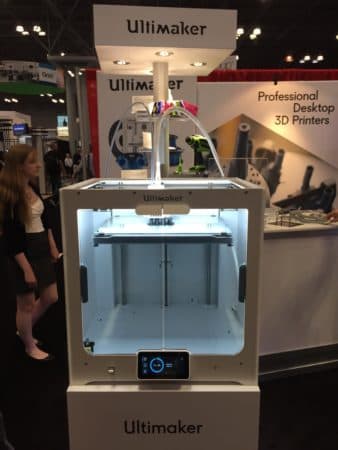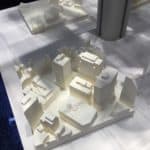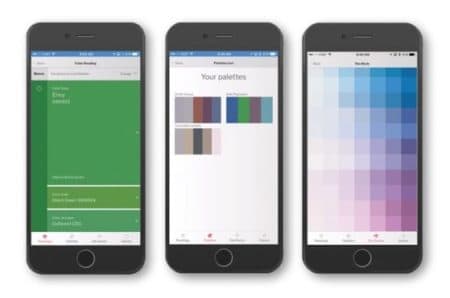Okay, we return with our Show Reports this week from the 2018 AIA National Convention, and Expo held two weeks ago in New York City.
We have already noted what he bigger AEC software companies were showing in NYC here. This report will drill down to the smaller notable companies and some companies we just met. Every year there is always some new companies exhibiting and this year was no different.
Also, our Perspectives on the BEST of SHOW is just a few days out from being published. We are very excited to share that feature as it will contain some original insights about the AEC tech industry that you will not find anywhere else.
Reports From the Show Floor
Ultimaker
We are going to start off with 3D printer company, Ultimaker. I met this company on the exhibit floor at the Develop 3D Conference in Boston last fall, held at Boston University. I had encouraged them to attend AIA and to bring architectural and urban design sample models. Here are a few shown below and aren’t they awesome? Why would you build models out of foam when you can do this?

01 – Ultimaker 3D printers were hot items for show-goers at AIA 2018 this year…their abilities include the use of water-dissolving materials in dual material printing.
The company was showing the new Ultimaker S5 at the show along with another model I believe. The S5 retails for $5,995.USD. The Ultimaker 3 retails for $3,495.USD. Both can print with two colored materials.

02 – 3d printers can print in a variety of materials by nylon is one of the key materials and very ideal for architectural models.

03 – Urban design models are some of the best items to have 3D printers produce for you. Why cut foam when 3D printers can rapidly produce these?
Ultimaker 3D printers can print in a variety of materials for a variety of purposes useful to the architectural process. While urban design models are shown above, concept models can be printed as well, at varying scales. Models for items in architecture you touch can be produced as well, such as custom door and window hardware, custom lighting and other objects in buildings that architects may be designing. Nylan is a popular material for 3D printing, while PLA and Tough PLA are great for visual prototypes. Other materials that the printer can accept and use are ABS, CPE, PVA water soluble materials designed to aid in printing complex geometries in dual extrusion work, PC, TPU 95A, PP, etc.
Ultimaker Cura software for macOS, Linux, and Windows means each major computer platform has options for use with the printers. Cura prepares your models for 3D printing by optimizing the data which is STL file format data. There are specific plugins for SolidWorks, Siemens NX, and Autodesk products. To learn more visit here.
Enscape
Enscape was a new exhibitor this year at AIA National. The German software company produces a rendering plugin solution for Revit, SketchUp, Rhino, and ARCHICAD. Unfortunately, the company doesn’t produce the plugin for the Apple macOS platform, despite three of those tools above being on the Mac. This will be disappointing because Enscape is a very nice real-time rendering solution.

04 – Enscape makes an excellent real-time rendering plugin for leading AEC software tools. Sadly, they don’t make it for macOS and have little interest from my discussions with the company.
Essentially what is good or great about Enscape is its rendering quality. It’s impressive for a real-time engine, and it’s their own rendering engine—not a licensed engine or a game engine. This is in sharp contrast to folks like Twinmotion which utilize the Unreal Engine. The advantages of real-time rendering are the potential “interactivity” with the subject matter. We have already spoken about the emergence of “interactive rendering” over traditional rendering where you wait for super high-quality finished stills or animations.
Enscape is simple to use and also provides “one click VR” in addition to video export for sophisticated animations with keyframe support and visual cameras in the main viewport. To learn more visit them here.
Datacolor ColorReader and ColorReader Pro
Another new attendee at AIA National this year was Datacolor. One of the world’s leading color management solutions companies, Datacolor does a lot more than produce the neat little gizmo and app we awarded an Honorable Mention to in the new Mobile+Cloud+Web category.

01 – The DATACOLOR ColorReader and ColorReader Pro models sit on the counter. The app runs on iOS and Android.
The Datacolor ColorReader Pro solves a narrow pain-point useful for interior decorators and architects alike—finding out color data on a physical object. Using benchtop spectrophotometer technology brought down to a little hand-held device, the ColorReader comes in a ColorReader Pro version or a non-pro version shown in the images below. Simply put the device on a material and push a button and your app on your smartphone reveals the color data for the color the device is reading.
The ColorReader and ColorReader Pro (both devices shown in the image above) work via Bluetooth. In the Pro model, a button on the top of the device starts the color-reading process. The non-Pro model must rely on the app to initiate the color-reading process. Typically, in workflows, the app will be already open once you begin using the device. The app itself is very nicely laid out and logical with a good UI/UX.
Remember when the iPod stored 1000 songs in your pocket? The ColorReader Pro stores 10,000 colors. Once a color is scanned, from just about any material, you get matching paint manufacturer color data—so a designer can use this to measure the color of a wall and then get the matching color from a particular paint line. More importantly, the color meter can take colors out of fabrics and other materials to match up in both paints, plastic laminate and other colored materials and finish systems.

08 – the iOS app’s user interface showing color capture data and palettes and spectrum information. (image: DATACOLOR)
Paint manufactures color lines in the system include Behr, Ben Moore, Farrow & Ball, PPG, Sherwin Williams, Valspar, NCS, and RAL brands (in Europe NCS and RAL collections only). The Readers also provide Hex values for taking color to the computer screen and the web. RGB and CYMK values are also included but not Pantone colors. The ColorReader Pro retails for $249.USD. The non-Pro model was just under $100.USD. To learn more visit Datacolor here to learn about the ColorReader Pro.




Reader Comments
Comments for this story are closed